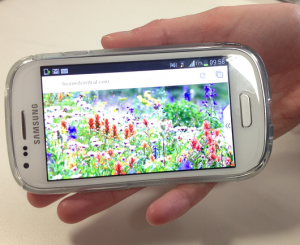生物多样性研究未来的宏伟愿景是技术创新的核心,并呼吁在数据共享,标准化和公民科学方面更加开放。
 您的智能手机可能只是帮助我们了解自然世界的运作方式。拍摄一张鸟的图片,用何时和何时将其标记图像,您可能会帮助科学家理解(很可能可以节省)世界的生物多样性。
您的智能手机可能只是帮助我们了解自然世界的运作方式。拍摄一张鸟的图片,用何时和何时将其标记图像,您可能会帮助科学家理解(很可能可以节省)世界的生物多样性。
Understanding what gives rise to the massive diversity of life on earth is perhaps the great challenge of ecological research. But to be able to predict how changes to this global system will affect the plants and creatures that live within it requires linking together huge amounts of information collected at very different scales of time and space – from microbes growing in seconds to plants competing over millennia; from nutrients cycling over nanometres to whales migrating across oceans.
移动技术只是帮助链接有关生物多样性的信息和想法的方法之一,以最终了解驱动和维护它的方法。
An文章今天发表inBMC生态学,雄心勃勃的范围和丰富的想法,概述了生物多样性研究的未来的宏伟愿景,该研究旨在回答这些问题,将开放性置于核心。
Here, Alex Hardisty from Cardiff University and Dave Roberts from London’s Natural History Museum release their vision of the next decade in biodiversity research and what needs to be done to move our understanding of the natural world into the digital age. Their white paper, written in collaboration with the Biodiversity Informatics community, was compiled through a huge community consultation effort after plans for the paper were released onto a public GoogleDoc. Individual contributions from 77 leaders in the biodiversity informatics field were compiled and edited by the authors to create a comprehensive vision for the future, representing a call-to-arms for funding priorities in this area.
关于复杂性和联系
作者认为,这一愿景的核心是需要以完全可互操作的方式进行标准化,公开存储并将不同的数据集链接在一起。在这种情况下,基因组学领域是一个有用的类比,在数据共享,标准化和工具开发中的开放性文化都结合起来,将知识的进步作为测序技术的成本下降。
In contrast, the numerous tools currently available in biodiversity informatics often employ differing architectures working on differing agendas. By creating an over-arching vision, it is hoped that commonality of purpose may bring coordination toward a common goal.
生物多样性研究进展的重大障碍是获取数据。跨学科,只有大约6-8%的研究人员deposit their data在档案中。结合很难从商业出版商拥有的版权中恢复数据,以及对许可和版权之间差异的广泛误解,许多研究人员不愿公开发布其数据。作者巧妙地总结了此问题:
“尽管取得了长足的进步,但生物多样性科学仍然依赖不完全可用,可连接,可发现和可访问的数据”
英国皇家学会等科学机构 - 没有出版生物多样性的陌生人,例如臭名昭著鱼的历史- 现在还要求在数字时代更加开放,并朝着science as an open enterprise:“…尽管科学家通常会通常利用数字时代的大量数据量和计算能力,但该方法通常是纸质时代的繁殖而不是数字时代”
名字叫什么?
尽管有人可能会说分类法已经到了数字党很晚 - 例如,请参见,最近采用了ICZN和洲际弹道导弹of electronic records for species names—the opportunities now available to move species descriptions beyond the simple binary taxonomy of Linnaeus mean that taxon names may now act as access keys, unlocking information on habitats, occurrence, feeding traits, and a wealth of other information on an organism’s ecology.
在此愿景中概述的解决方案是每个名称都被分配一个持久和唯一的标识符,与基因型信息存储在诸如GenBank之类的存储库中的方式相同,将有关基因级别的单个物种的信息链接在基因级别上的信息。到整个生态系统。
在这样一个系统存在一个是traditional Linnaean classification may be lost, replaced by cold ID numbers. No moreHyloscirtus princecharlesi, no moreAgra katewinsletae. While this suggestion may risk offending practising taxonomists, the authors argue that at the rate of current species identification through these methods, the goal of achieving a comprehensive inventory of life on earth is unrealistic.
Advances in molecular barcoding and metagenomics are put forward as an alternative, high-throughput solution to this problem – a technological advance to tackle a logistical conundrum. The caveat to all of this, however, is how to move computational power to the data?
Providing sufficient computational infrastructure with which to analyze the vast volumes of data that might be produced by this approach remains to be seen.
Social media and the citizen scientist
Underlying much of this grand challenge is the potential to utilise the vast opportunities presented by modern technologies. This grand vision sees biodiversity researchers of the future becoming much better connected, with social media platforms providing an ideal venue for data and ideas to be shared efficiently.
 But it is not just professional scientists who will drive these changes. Citizen scientists will be able to play a key role in enabling the vast amount of data needed to provide a system-wide perspective; encouraging future resources to be driven toward new creating new mobile technologies. Smartphone apps will be a key feature enabling amateur naturalists and enthusiastic volunteers to become tomorrow’s data-gatherers.
But it is not just professional scientists who will drive these changes. Citizen scientists will be able to play a key role in enabling the vast amount of data needed to provide a system-wide perspective; encouraging future resources to be driven toward new creating new mobile technologies. Smartphone apps will be a key feature enabling amateur naturalists and enthusiastic volunteers to become tomorrow’s data-gatherers.
From bird-spotters tagging species occurrences with georeferences, to armchair curators cataloguing, digitising and annotating the bewildering numbers of specimens locked away in museum vaults and private collections—the future of species identification looks likely to be greatly enhanced by the help of enthusiastic non-professionals, as access to better technology makes this ever more feasible. Crowd-sourced projects such as theAtlas of Living Australia毫无疑问,将有助于使地球上的生命分类的巨大任务似乎有些艰巨。
但是,科学可能是由技术驱动的,反之亦然吗?作者认为否,说新技术的可用性允许新的光芒在以前在黑暗中的研究领域发光:”当灯光变化时,科学也是如此。”
Only by making tools available to facilitate data sharing, and fostering a culture of open science in the research community, will this vision be realised in the next decade –and beyond.
In the spirit of openness, the full text from this white paper is available under the most unrestrictive of licences,CC0.
[…]了解是什么推动了地球上巨大的生命,也许是生态学研究的巨大挑战。亚历克斯·哈迪斯蒂(Alex Hardisty)和戴夫·罗伯茨(Dave Roberts)通过概述了对生物多样性研究的生物多样性研究未来的宏伟愿景,这使我们更接近实现这一梦想,在与生物多样性信息学信息社区进行了巨大的社区咨询工作之后,这将技术创新和数据共享源于其核心。我们的博客解释了您的智能手机如何拯救自然世界。[…]